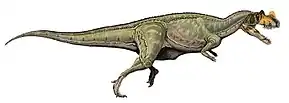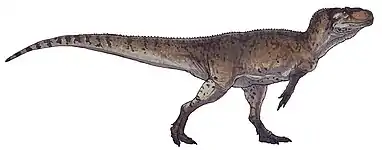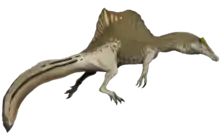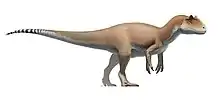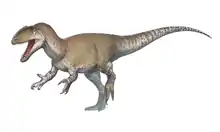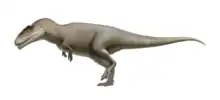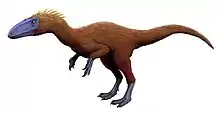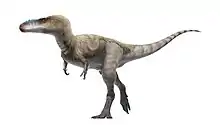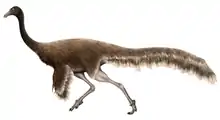Lusovenator
Lusovenator (meaning "Portuguese hunter") is a genus of carcharodontosaurian theropod dinosaur, from the Late Jurassic (Kimmeridgian) Praia de Amoreira Porto-Novo Member of the Lourinhã Formation in present-day Portugal. It includes one species, Lusovenator santosi.[1]
| Lusovenator | |
|---|---|
| Scientific classification | |
| Kingdom: | Animalia |
| Phylum: | Chordata |
| Clade: | Dinosauria |
| Clade: | Saurischia |
| Clade: | Theropoda |
| Clade: | †Carcharodontosauria |
| Genus: | †Lusovenator Malafaia et al., 2020 |
| Type species | |
| †Lusovenator santosi Malafaia et al., 2020 | |
Discovery and naming
The holotype was discovered during the 1980s by José Joaquim dos Santos and he donated his fossil collection to the Sociedade de História Natural around thirty years later. The unnamed holotype was described and placed in the Allosauroidea in 2017.[2] The neotype was described in 2019 and both specimens were placed within Carcharodontosauria.[3] The species Lusovenator santosi was named and described in 2020.[1]
The known remains consist of the holotype SHN.036 - "a partial postcranial skeleton preserving the odontoid, the atlantal intercentrum, a cervical vertebra, isolated cervical neural spines, dorsal vertebrae, fragments of sacral vertebrae, caudal vertebrae, chevrons, fragments of cervical and dorsal ribs, the right ilium, both pubes, and ischia", thought to represent a juvenile individual - and the neotype SHN.019, "a partial skeleton represented by a series of articulated caudal vertebrae and an almost complete right pes".[1]
Etymology
The generic name Lusovenator is derived from Lusitania, the province of the Roman Empire that was located in present-day Portugal, affixed with the Latin venator, meaning "hunter". The specific name, L. santosi, refers to José Joaquim dos Santos, who discovered the remains.[1]
Classification
The describers ran a phylogenetic analysis and recovered Lusovenator within the clade Carcharodontosauria, outside Carcharodontosauridae and Neovenatoridae. Their cladogram is shown below:[1]
| Allosauroidea |
| ||||||||||||||||||||||||||||||
References
- Elisabete Malafaia; Pedro Mocho; Fernando Escaso; Francisco Ortega (2020). "A new carcharodontosaurian theropod from the Lusitanian Basin: evidence of allosauroid sympatry in the European Late Jurassic". Journal of Vertebrate Paleontology. Online edition: e1768106. doi:10.1080/02724634.2020.1768106.
- Malafaia, E., P. Mocho, F. Escaso, and F. Ortega. 2017. "A juvenile allosauroid theropod (Dinosauria, Saurischia) from the Upper Jurassic of Portugal". Historical Biology 29 : 654–676
- Malafaia, E., P. Mocho, F. Escaso, P. Dantas, and F. Ortega. 2019. "Carcharodontosaurian remains (Dinosauria, Theropoda) from the Upper Jurassic of Portugal". Journal of Paleontology 93 : 157–172
